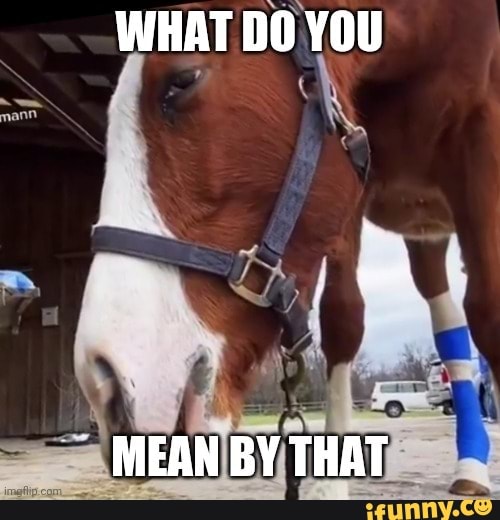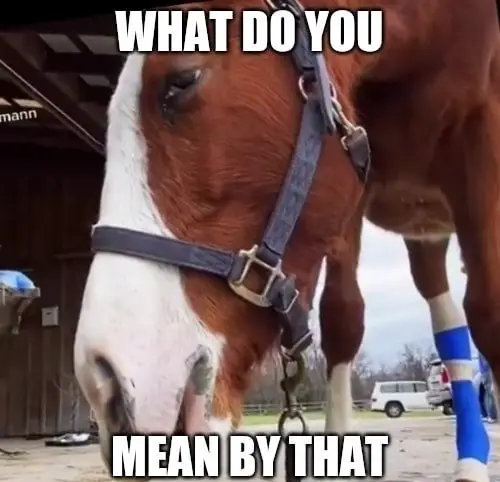“What Do You Mean by That Horse” is a question seeking clarification on the meaning or intention behind a specific reference to a horse. Now, let’s explore the various interpretations and contexts surrounding this question in further detail.
The phrase “What Do You Mean by That Horse” can be more than just a literal inquiry about the literal meaning of the word “horse. ” It may also imply a request for clarification or explanation of a metaphorical or symbolic reference to a horse in a conversation, text, or artwork.
This question highlights the importance of context and understanding the intended message or symbolism behind the mention of a horse. By delving deeper into the specific connotations associated with horses in different cultures, literary works, or expressions, we can shed light on the intended meaning behind “that horse. ” So, let’s explore the rich history and cultural significance of horses to grasp the deeper implications of this question.
Evolutionary Origins
Evolutionary Origins
Studying horse fossils provides insights into their evolutionary origins. The evolution of horses can be traced back millions of years. Fossils found in various parts of the world provide evidence of the different stages of horse evolution. These fossils show the gradual changes that occurred over time, leading to the modern-day horse.
| Stage | Description |
|---|---|
| Eohippus | The earliest known horse ancestor, about the size of a dog. |
| Mesohippus | Smaller than Eohippus, with more advanced teeth. |
| Merychippus | A larger horse with a significant increase in tooth structure. |
| Pliohippus | Characterized by an increase in body size and longer limbs. |
| Equus | Modern-day horses, with adaptations for speed and grazing. |
The study of horse fossils allows scientists to understand the evolutionary processes that shaped these magnificent creatures. By examining the anatomical changes and environmental factors that influenced horse evolution, scientists can piece together the fascinating story of their origins.

Credit: br.ifunny.co
Domestication And Early Uses
The domestication of horses was a significant milestone in human history. Horses were first domesticated around 4000 BCE by the Botai culture in what is now modern-day Kazakhstan. These early domesticated horses were smaller in size compared to the modern horse and were primarily used for their meat and milk.
As civilizations began to develop, horses played crucial roles in various ancient cultures. In Mesopotamia, the horse was used for transportation, agriculture, and warfare. Horses pulled chariots, allowing for faster and more efficient travel. They also played a vital role in military campaigns, providing a tactical advantage to civilizations like the Assyrians and Persians.
Ancient Egypt also held the horse in high regard. They were used for transport, trade, and warfare. Horses were depicted in ancient Egyptian art, showcasing their importance in their society. Similarly, in ancient Greece, horses were used for transportation and in battle, with cavalry units becoming an integral part of military strategies.
Overall, the domestication of horses revolutionized early societies, providing them with a reliable means of transportation, improved agriculture, and advancing military capabilities. This showed the tremendous impact horses had on ancient civilizations.
Modern Uses And Breeds
Modern Uses and Breeds Horses as working animals The horse has been a valuable working companion to humans for centuries. From agriculture to transportation, horses have played a crucial role in various industries. Today, horses continue to be used in a number of working capacities. One popular modern use for horses is in the field of agriculture. They are utilized in tasks such as plowing fields, pulling carts, and transporting heavy loads. Their strength and endurance make them ideal for these types of work. Horses also serve as reliable modes of transportation in certain areas. They are used for recreational purposes such as trail riding and carriage tours. Additionally, some regions still rely on horses for transportation in areas where motorized vehicles are difficult to access or impractical. When it comes to popular horse breeds today, there are several noteworthy ones. The American Quarter Horse, known for its agility and speed, is highly sought after for rodeo events and as a versatile working horse. The Thoroughbred, famous for its racing abilities, is another popular breed. Other breeds such as the Arabian, Paint, and Appaloosa also have dedicated followings for their unique characteristics and versatility. In conclusion, horses play a crucial role in various industries as working animals. Their strength, endurance, and unique abilities make them valuable assets in areas such as agriculture and transportation.External Features
htmlHorses have specialized structures for their locomotion. Their hooves and legs are crucial for their stability and mobility. Horses have large, sturdy hooves that are adapted for running, jumping, and supporting their body weight. The hooves protect the sensitive structures within and provide traction on various terrains. The legs are long and muscular, allowing horses to move swiftly and with elegance. They have a powerful anatomy that enables them to carry both their own weight and that of a rider. The strength and structure of their legs play a vital role in their overall movement and athleticism.
Horses come in a wide variety of coat colors and patterns, showcasing their individuality and beauty. From solid colors such as black, brown, and white to complex patterns like roan, pinto, and appaloosa, each horse exhibits distinct markings. The coat color is determined by the distribution and intensity of pigments on the horse’s body. Some horses have unique markings on their face and legs, while others may have spots or patches on their body. These coat patterns can vary greatly and are often influenced by genetics. Whether solid or patterned, the coat color of a horse adds to its charm and allure.
Internal Structures
Digestive System
A horse’s digestive system is incredibly complex and plays a crucial role in its overall health and well-being. The digestive process begins in the horse’s mouth, where powerful teeth and grinding motions break down food into smaller particles.
Once in the stomach, enzymes and acids work to further break down the food, facilitating the absorption of nutrients. The small intestine then plays a vital role in the absorption and digestion of proteins, carbohydrates, and fats. Undigested material is passed into the large intestine, where fermentation and absorption of water take place.
Respiratory System
The horse’s respiratory system consists of the nasal passages, throat, trachea, and lungs. When a horse breathes in, air enters through the nostrils and travels through the nasal passages. The throat, or pharynx, connects the nasal passages to the trachea, which is supported by cartilage rings.
From the trachea, air moves into the bronchi and then into the lungs, where gas exchange occurs. Oxygen is transferred into the bloodstream, while carbon dioxide is removed. The respiratory system also includes various defensive mechanisms to filter out dust and other airborne particles, helping to maintain optimal lung health.
Musculoskeletal System
Musculoskeletal System
The musculoskeletal system is a complex network of bones, muscles, and connective tissues that work together to support the body’s structure and allow for movement. At the core of this system is the skeletal structure, which provides the framework for the body. It consists of bones, cartilage, and ligaments that form joints and help protect vital organs. The muscular system, on the other hand, is responsible for the movement of the body. It is made up of muscles, tendons, and fascia, which work together to produce voluntary and involuntary movements. Muscles are attached to bones via tendons, and when they contract, they pull on the bones, allowing for movement. The musculoskeletal system plays a crucial role in maintaining posture, supporting the body’s weight, and enabling physical activity. It is essential to maintain the health of this system through proper nutrition, exercise, and preventive care to ensure optimal function and reduce the risk of injury.
Social Structure
htmlWhat Do You Mean by That Horse – Social Structure
Horses are highly social animals, and their social structure is based on herd dynamics. Each herd has a specific hierarchy, with dominant individuals holding higher ranks. The social hierarchy is primarily established through dominance interactions such as aggressive displays and physical confrontations.
In a horse herd, there are different roles and positions that horses can assume:
| Role | Description |
|---|---|
| Dominant Horse | The highest-ranking individual in the herd. It maintains control over resources, such as food and mates, and often leads the group. |
| Subordinate Horse | Horses with lower ranks in the hierarchy. They may show deference towards higher-ranking horses and have access to resources based on their position. |
| Lead Mare | The dominant female horse in a herd. She plays a crucial role in leading the group and protecting it from potential threats. |
| Follower Horses | Horses that follow the lead mare and assist in maintaining the herd’s cohesion. They may act as sentinels, watching for potential dangers. |
Understanding the social structure of horses and their herd dynamics is essential for horse owners and caretakers. It helps in creating appropriate living conditions and maintaining a harmonious environment for these magnificent animals.
Communication Signals
Communication Signals
Body language: Horses primarily rely on their body language to communicate with each other and with humans. Their movements, postures, and facial expressions can convey a range of emotions and intentions. For example, a horse that pins its ears back and tucks its tail is often displaying signs of aggression or discomfort. On the other hand, a relaxed and confident horse will have a relaxed posture with ears pricked forward and a fluid gait.
Vocalizations: In addition to body language, horses also use vocalizations to communicate. They have a variety of vocal sounds, each with its own meaning. For instance, a loud neigh is often a call for attention or an expression of excitement, while a soft nicker is a friendly greeting. By paying attention to these vocalizations, handlers can better understand a horse’s needs and emotions.
Instinctual Behaviors
Flight Or Fight Response
Horses are known for their flight or fight response. When faced with a perceived threat, they have a natural instinct to either flee the situation or stand their ground and defend themselves. This behavior is a result of their survival instincts and can be observed in various situations. Often, horses will exhibit signs of anxiety, such as raised head, wide eyes, and a tense body posture, when they feel threatened. It is important for horse owners and handlers to understand and respect this instinctual behavior to ensure the safety of both the horse and the humans involved.
Grazing And Foraging Habits
Horses are herbivores and have evolved to spend a significant amount of their time grazing and foraging for food. This instinctual behavior is influenced by their natural diet in the wild, which primarily consists of grasses and forage. Horses have a unique digestive system that requires them to eat small amounts of food frequently throughout the day to maintain optimal health. Grazing allows horses to ingest large quantities of fibrous materials, which help to regulate their digestion and prevent issues like colic. Providing horses with access to pasture or high-quality forage is essential to ensuring their well-being and fulfilling their natural grazing instincts.
Frequently Asked Questions For What Do You Mean By That Horse
What Is The Definition Of A Horse?
A horse is a large mammal with a long neck, a flowing mane, and a slender body. They are known for their agility, speed, and strength, and have been used for transportation, farming, and recreation for centuries.
What Are Some Common Horse Breeds?
There are numerous horse breeds, each with its own characteristics and abilities. Some common horse breeds include the Thoroughbred, Arabian, Quarter Horse, and Morgan. These breeds differ in size, temperament, and intended use.
How Long Do Horses Live?
The average lifespan of a horse is around 25 to 30 years, but it can vary depending on factors such as breed, care, and health. With proper care and nutrition, horses can live well into their 30s. Regular veterinary check-ups and a balanced diet are essential for their longevity.
Conclusion
Horses are majestic creatures that hold significant meaning in many cultures around the world. From their grace and power to their role in history and mythology, horses continue to captivate our imagination. Whether you ride them for leisure, compete in equestrian sports, or simply admire them from afar, the bond between humans and horses is truly special.
So, next time you see a horse, take a moment to appreciate their beauty and the multitude of meanings they embody.

